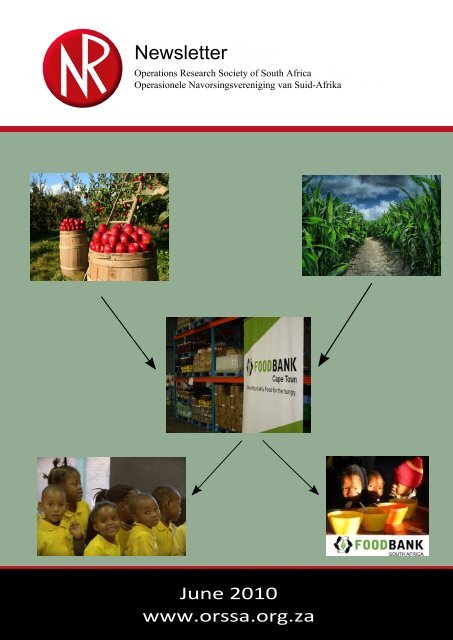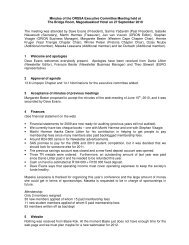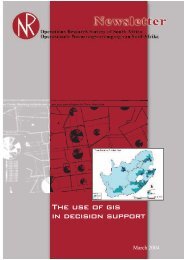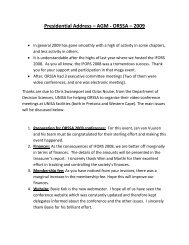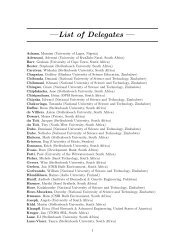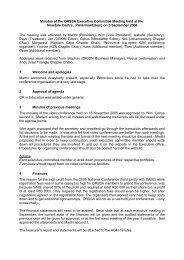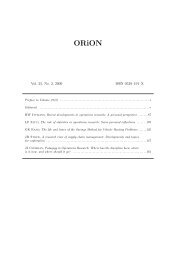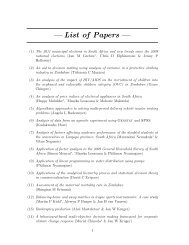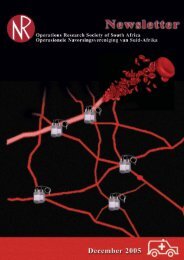Newsletter - ORSSA
Newsletter - ORSSA
Newsletter - ORSSA
Create successful ePaper yourself
Turn your PDF publications into a flip-book with our unique Google optimized e-Paper software.
<strong>Newsletter</strong><br />
Operations Research Society of South Africa<br />
Operasionele Navorsingsvereniging van Suid-Afrika<br />
June 2010<br />
www.orssa.org.za
June 2010<br />
FROM THE EDITOR<br />
Contactable at: 14556561@sun.ac.za<br />
Danie Lötter<br />
Welcome to the June<br />
edition of the newsletter.<br />
First of all I would really like<br />
to thank members for their<br />
contributions to the<br />
newsletter. I also want to<br />
make use of this<br />
opportunity to urge<br />
members to submit more<br />
contributions for the<br />
newsletter, especially the submission of articles. For the<br />
interested readers I have included a number of<br />
upcoming conferences. This edition starts off with the<br />
letter from the president, Dave Evans, followed by a<br />
summary of the 2010 executive committee. An obituary<br />
on Cas Troskie from the University of Cape Town is also<br />
included. The article featuring in this edition is a case<br />
study on decision support for Foodbanking by Esbeth<br />
van Dyk form the CSIR, Theo Stewart from the<br />
university of Cape Town and Tim Blake from South<br />
African Breweries. And last but not least, the member<br />
interview is conducted with James Bekker from the<br />
University of Stellenbosch. Enjoy<br />
Features<br />
FROM THE EDITOR<br />
FROM THE PRESIDENT’S DESK<br />
<strong>ORSSA</strong> EXECUTIVE COMMITTEE<br />
2010<br />
OBITUARY – CAS G TROSKIE<br />
DECISION SUPPORT FOR<br />
FOODBANKING: A CASE STUDY<br />
MATIES TAKES ON IKEYS IN OR<br />
MEMBER INTERVIEW : JAMES<br />
BEKKER<br />
Page<br />
1<br />
2<br />
2<br />
3<br />
6<br />
9<br />
11<br />
QUERIES AND CONTRIBUTIONS<br />
DISCLAIMER<br />
The views expressed in this newsletter are those of the<br />
contributors and not necessarily of the Operations<br />
Research Society of South Africa. The society takes no<br />
responsibility for the accuracy of details concerning<br />
conferences, advertisements, etc., appearing in this<br />
newsletter. Members should verify these aspects<br />
themselves if they wish to respond to them.<br />
Any queries and contributions to the newsletter are<br />
most welcome, especially article submissions. For<br />
any queries and contributions, please contact the<br />
newsletter editor: Danie Lötter<br />
Email: 14556561@sun.ac.za<br />
The December 2009 issue of the IFORS News is now<br />
available online on the IFORS website www.ifors.org<br />
For the interested readers, an electronic version is<br />
also available in PDF format from the following link:<br />
http://www.ifors.org/newsletter/IFORS_DEC09.pdf<br />
1
June 2010<br />
FROM THE PRESIDENT'S DESK<br />
by Dave Evans (davee@dbsa.org)<br />
<strong>ORSSA</strong> President<br />
Dear <strong>ORSSA</strong> members,<br />
Subscriptions: You should by<br />
now have received hard copy<br />
statements from our Treasurer,<br />
Marthi Harmse, with details of<br />
your subscriptions due. If you<br />
haven’t, we would be extremely<br />
grateful if you could let Marthi<br />
know so she can resend it:<br />
Sarma Yadavalli<br />
marthi.harmse@sasol.com or kmharmse@mweb.co.za<br />
Likewise, if you would prefer it electronically, please let<br />
her know. Our collections of subscriptions fees last year<br />
was quite poor. Our postal service is pretty unreliable<br />
these days, and it may well be because you did not<br />
receive your statement. If that is the case, your<br />
statement this year will be for two years’ worth of fees.<br />
Our apologies for it hitting you like that – please do pay<br />
both years’ fees. Another possibility is that you did pay<br />
last year, electronically, and it came through on our<br />
bank statement unidentifiably; we get a couple of those<br />
every year. If you did pay last year and your statement<br />
doesn’t reflect that, please let Marthi know, with the<br />
details of when and how.<br />
<strong>ORSSA</strong> 2010 Conference: Our conference is being<br />
hosted this year by the University of Limpopo at the<br />
delightful Magoebaskloof Hotel, on the edge of the<br />
Highveld escarpment, east of Polokwane, near Tzaneen.<br />
(Details elsewhere in this newsletter.) Registration<br />
details are also on the website – please get your<br />
registration in and papers submitted as soon as<br />
possible, and help us make it into another successful<br />
<strong>ORSSA</strong> conference.<br />
<strong>ORSSA</strong> in Development: The focus on how <strong>ORSSA</strong> can<br />
contribute more to Development in our country is<br />
picking up momentum. A group of us had a meeting<br />
with one of the country’s leading educationalists a few<br />
weeks ago. I have also spoken with other people in the<br />
health and infrastructure areas and am taking these<br />
engagements forward. The idea is for members of the<br />
society to contribute to them in the way of a normal<br />
business engagement – not in any kind of ‘spare time’<br />
or ‘pro bono’ (i.e. free) way. As I said in the last<br />
2<br />
newsletter, please contact me (with absolutely no<br />
obligation from your side) if you are interested in<br />
looking closer at these activities. The potential for the<br />
society, through its members, to make a meaningful<br />
contribution to job creation, economic growth and<br />
service delivery is significant. To use the same closing<br />
line as last time, the need is almost infinite, and there is<br />
a great opportunity to use OR in Development, to the<br />
overall long term benefit of the whole country – let’s<br />
make a difference!<br />
NEW <strong>ORSSA</strong> EXECUTIVE COMMITTEE 2010<br />
President:<br />
Dave Evans<br />
Vice-President:<br />
Sarma Yadavalli<br />
Secretary:<br />
Isabelle Nieuwoudt<br />
Treasurer:<br />
Marthi Harmse<br />
ORiON editor:<br />
Jan van Vuuren<br />
ORiON Business Manager:<br />
Stephan Visagie<br />
Newletter editor:<br />
Danie Lötter<br />
<strong>Newsletter</strong> Business<br />
Manager:<br />
Francois Bester<br />
Webmaster:<br />
Basie Kok<br />
Additional members:<br />
Ozias Ncube Maseka Lesaoana<br />
Tilla Fick Ian Durbach<br />
Chapter Chairs: Johannesburg:<br />
Pretoria:<br />
Vaal Triangle:<br />
Western Cape:<br />
IFORS Representitive:<br />
Hans Ittmann<br />
Neil Manson<br />
Winnie Pelser<br />
Hennie Kruger<br />
Margarete Bester
June 2010<br />
OBITUARY – CAS G TROSKIE<br />
Assembled by Theo Stewart from notes compiled by<br />
Christien Thiart and June Juritz<br />
Cas G Troskie<br />
Casparus Gerhardus Troskie was<br />
born on 2 October 1936 at Nigel<br />
in the old Transvaal. His surname<br />
came from a Polish ancestor who<br />
had come to South Africa in the<br />
1760’s. His first and second name<br />
were shared with a very long line<br />
of his Troskie forebears, and is<br />
now carried by his eldest son.<br />
Cas was of Afrikaner stock. Some of his grandparents<br />
had been interred in Boer War concentration camps as<br />
young people. He grew up in Springs and was always<br />
greatly pleased to report that he had vied for academic<br />
honours in all those early years in the same class with<br />
one Wieland Gevers, sometime Rhodes Scholar,<br />
professor of Medicine and later Deputy Vice Chancellor<br />
at UCT.<br />
This story was never told boastfully, but instead it was<br />
part of Cas’s character to rejoice in the achievements of<br />
others, especially his friends and acquaintances, as well<br />
as to be grateful for his own.<br />
A youthful Cas entered the University of Pretoria<br />
studying Mathematics and Mathematical Statistics as<br />
his major subjects. His first degree was a BSc in 1957<br />
and an MSc in 1960. From 1957 he worked at the<br />
National Research Institute for Mathematical Sciences<br />
of the CSIR, for six years. While employed there, he<br />
completed in 1963 a PhD entitled Regression<br />
applications of multivariate distributions, through<br />
UNISA.<br />
At University of Pretoria he met another outstanding<br />
student of mathematical disciplines, Irene Dracht,<br />
whom he married in 1962 (in New York). During 1962<br />
using special leave from the CSIR, he and Irene had an<br />
extended stay at Columbia University, New York. It was<br />
there that he began to build up a substantial set of<br />
international contacts. Some of the contacts led to visits<br />
in later years by high profile statisticians to the South<br />
African universities, and many contacts were important<br />
links for his post-graduate students, especially when<br />
snail-mail was the only option of communication.<br />
Cas Troskie was appointed as first professor and<br />
founding Head of the Department of Mathematical<br />
Statistics at UCT in 1966 (when he was not yet 30 years<br />
old). He introduced many innovations. Applied work<br />
was initially performed with the contemporary<br />
mechanical calculators, powered by repeated<br />
application of clockwise and anti-clockwise rotations.<br />
The hand spun until the ring of a bell signalled the need<br />
for a one-place movement of the register to a next digit.<br />
But within a few years he moved the Department to the<br />
wonders of a large electrical calculator with moving<br />
parts, the size of an ancient cash register.<br />
Not long afterwards he found a sponsor for a booksized<br />
desk-top electronic calculator which could<br />
perform arithmetic and find a square root, and gave<br />
answers on a little screen of tiny lights. Finally he<br />
introduced the hand-held HP calculators that could be<br />
programmed in a language notation called reversed<br />
Polish. He always chuckled at this name.<br />
He chose to direct his PhD’s theory of multivariate<br />
analysis and associated work on outliers and anomalous<br />
observations into applications on the Johannesburg<br />
stock exchange. This orientation led him into the theory<br />
of time series and econometrics, but also to special<br />
expertise about the stock exchange. He supervised 24<br />
MSc and 14 PhD students mainly in these domains, and<br />
furthered his expertise during sabbaticals at the<br />
University of Gottingen (1980) and Stanford University<br />
(1986).<br />
Of particular interest to the OR community is that this<br />
(at the time novel) extension into important practical<br />
business applications led, inter alia, to establishment of<br />
a first comprehensive data base of JSE price movements<br />
(initially stored on punch cards and flown to Cape<br />
Town), and the development of operations research as<br />
a fundamental component of the activities of the then<br />
department of mathematical statistics at UCT (now<br />
called statistical sciences). As a direct result of these<br />
early initiatives in the 1960s and 1970s, the honours<br />
programme in statistical sciences at UCT (which<br />
includes the BBusSc stream in quantitative<br />
management) involves an integration of statistics and<br />
operations research, anticipating the modern emphasis<br />
on “analytics”.<br />
He built up a strong department, bringing in as staff or<br />
students many who would make their mark in the<br />
statistical and OR communities in South Africa and<br />
internationally, including as the years unfolded, June<br />
Juritz, Arthur Money, Michael Greenacre, Les Underhill,<br />
3
June 2010<br />
John Affleck-Graves, Trevor Hastie, Walter Zucchini and<br />
Theo Stewart.<br />
In his later years before retirement he was the Senior<br />
Professor at UCT, the longest serving current member<br />
of the professoriate. He warned of the calamity that<br />
might befall UCT if he were ever called upon to exercise<br />
that status under the terms of the University Act.<br />
Professionally, Cas was an active member of the South<br />
African Statistical Association and the Operations<br />
Research Society of South Africa. He served as SASA<br />
President in 1972. In later years he was elected a Fellow<br />
of the Association.<br />
In public life, Cas served on the Joint Matriculation<br />
Board, and its successor, the SA Certification Council, as<br />
statistician from 1972 until the foundation of Umalusi.<br />
He also sat on several regional Educational Councils. He<br />
was, for many years, a member of the Advisory Panels<br />
of the Institute for Biostatistics of the Medical Research<br />
Council and the National Research Institute for<br />
Mathematical Sciences of the CSIR.<br />
At the 2001 SASA Conference in his year of official<br />
retirement, he was asked to come up to the podium.<br />
Then his own former post-graduate students present<br />
were invited to join him, followed by their postgraduates,<br />
and so on, until at the seventh iteration, no<br />
further cohorts joined. More than half the conference<br />
participants stood with him.<br />
He enjoyed his years as Emeritus Professor and the role<br />
and access it gave him to continuing academic work.<br />
Cas was authentically humble, generous of spirit, but<br />
nonetheless no stranger to gaiety and enjoyment. He<br />
had loved playing rugby but an injury put a stop to its<br />
rigours. He embraced the surfboard before and after<br />
the age of the large hollow wooden boards, and passed<br />
this passion on to his sons. He and Irene engaged the<br />
vicissitudes of the little white ball, but he said she was<br />
the better player. And he delighted in a party.<br />
Cas suffered from rugby injuries, psoriasis, and also<br />
from defective vision for at least three decades. The eye<br />
problems gave rise to increasing difficulties and<br />
debilitating infections and irritations. After numerous<br />
operations he lost the vision in one eye, and towards<br />
the end of his life was virtually blind. From a<br />
considerable time before his death he could no longer<br />
drive a car, and he did not relish this circumstance and<br />
its constraints.<br />
These burdens he bore with stolid acceptance. He was<br />
acutely conscious of the role Irene had played in making<br />
his successes possible. He was a proud father of four<br />
sons Casparus, Roelof, Johan and Andre, a delighted<br />
grandfather of three boys and four girls. To all his family<br />
the UCT community extends its condolences.<br />
The passing of Cas Troskie is also the passing of an era<br />
of near 50 years of association with and service to the<br />
University of Cape Town. He was a kindly witness and<br />
enthusiastic participant in the enormous changes in the<br />
institution he deeply loved.<br />
We celebrate a life of a gentle colleague, generous with<br />
ideas and open in his disposition to support and<br />
encourage whatever talent or excellence came within<br />
his sphere of influence.<br />
May he rest in peace.<br />
SP XII 2010 Conference<br />
12 th International Conference<br />
on Stochastic Programming<br />
The 12 th international conference on Stochastic<br />
Programming will take place August 16-20, 2010 in<br />
Halifax, Nova Scotia. The conference aims to bring<br />
together the leading researchers in stochastic<br />
programming, practitioners in the field, students and<br />
users. For full details on the conference please visit the<br />
conference webpage on http://icsp12.dal.ca/<br />
The 19 th Triennial Conference of the International<br />
Federation of Operational Research Societies (IFORS)<br />
which will be hosted by the Victorian chapter of the<br />
Australian Society for Operations Research (ASOR). The<br />
conference will be held at the new Melbourne<br />
Convention Centre in the centre of the city of<br />
Melbourne, Australia from the 10 th to the 15 th July 2011<br />
and will bring operational researchers from around the<br />
globe together. Deadline for paper submissions is 15<br />
December 2010. For full details on the conference<br />
please visit the conference webpage on<br />
www.ifors2011.org.<br />
4
SAS<br />
Insurance industry soul-searching<br />
for better risk management<br />
The financial repercussions of the global economic downturn and weary market sentiment<br />
continue to be felt throughout South Africa, specifically in the insurance industry.<br />
Here risk remains high, in<br />
the midst of a drive in the<br />
market to create greater<br />
transparency, efficiency and<br />
improved performance.<br />
The insurance industry, in particular,<br />
despite the efforts from banks and<br />
regulatory bodies, is very aware of what<br />
impact the global recession is having<br />
on South Africa’s financial markets. It is<br />
no wonder that the way in which they<br />
identify, assess and manage these risks<br />
continue to remain under the spotlight.<br />
This is according to André Zitzke,<br />
Head of Risk Practice at SAS South<br />
Africa, who says that the recession has<br />
revealed the defects of a whole host of<br />
risk mitigation issues, and major soulsearching<br />
is now underway to ensure<br />
that the risk and controls functions<br />
in insurance institutions will be more<br />
robust, authoritative and accountable<br />
in future.<br />
“Regulatory bodies are increasingly<br />
eyeing the consequences of managed<br />
approaches to curb risk more<br />
pragmatically. The Financial Services<br />
Board (FSB) is progressing with its<br />
implementation of the new Solvency<br />
Assessment and Management (SAM)<br />
regime in 2010, which means that<br />
addressing issues such as data<br />
management, its data quality, analytics<br />
and reporting capabilities is becoming<br />
paramount,” he says.<br />
The SAM system is being introduced to<br />
address particular concerns related to<br />
governance, internal controls and risk<br />
management in both the long-term and<br />
short-term insurance sectors. The SAM<br />
system is similar to Basel II guidelines<br />
in the banking services industry, which<br />
provides a regulatory framework to<br />
promote the soundness of insurance<br />
companies through the effective<br />
application of international regulatory<br />
and supervisory standards.<br />
Zitzke says, as a result of the volatile<br />
industry riding the repercussions of<br />
the recession and pending legislations<br />
that would provide additional stress<br />
on existing and new staff, the global<br />
insurance industry shows a trend<br />
of investing much more on getting<br />
accurate and reliable data to support<br />
their risk functions.<br />
To make this investment more<br />
cost effective, Zitzke says SAS has<br />
introduced SAS Risk Management for<br />
Insurance, a solution that addresses<br />
enterprise risk management in the<br />
insurance industry comprising the<br />
three major requirements in the<br />
industry today. The solution includes<br />
an insurance-specific data model and<br />
framework that assists life and P&C<br />
insurance companies to implement the<br />
global Solvency II standard model and<br />
the therefore the local SAM regime for<br />
calculating risk-based capital costeffectively.<br />
“This allows insurers to more effectively<br />
manage risk, give organisations an<br />
industry standard data foundation,<br />
The insurance industry, in particular, despite the efforts from banks<br />
and regulatory bodies, is very aware of what impact the global<br />
recession is having on South Africa’s financial markets.<br />
comprehensive analytics and an<br />
industry leading reporting platform,” he<br />
adds. “With a robust risk management<br />
software solution, insurers can perform<br />
more accurate analysis, employing<br />
an enterprise risk repository that<br />
offers more comprehensive data<br />
management that results in better<br />
risk-based business decisions, and<br />
importantly, reduces the total cost of<br />
ownership.”<br />
Additionally, a single solution that can<br />
integrate seamlessly with current risk<br />
software investments, dramatically<br />
decreases the “cost to company”<br />
aspect of IT software solutions.<br />
The next version of the framework<br />
also enables insurers to support<br />
the internal model approach for risk<br />
André Zitzke, Head of Risk Practice<br />
SAS South Africa<br />
analysis, which provides another added<br />
benefit – providing senior management<br />
with a greater understanding of the<br />
company’s risk and financial condition,”<br />
he adds.<br />
Stress testing, in particular, says<br />
Zitzke, forms an integral part of the<br />
risk management portfolio, which<br />
tests an insurer’s assets and liabilities<br />
against the sudden, volatile changes<br />
in economic market conditions. New<br />
exciting developments at SAS will make<br />
this exercise less stressful for financial<br />
institutions.<br />
Across the industry, risk management<br />
has moved to the centre of strategic<br />
decision making, and many institutions<br />
are revamping their entire approach<br />
to understanding and mitigating<br />
the risks that they face. In fact, risk<br />
management, is not just a function<br />
of an insurer, it is the insurer,” he<br />
concludes.<br />
To learn more about how to meet<br />
the requirements for real-time<br />
decision making, contact SAS on<br />
+27 11 713 3400 (Johannesburg and<br />
Pretoria) or +27 21 912 2420 (Cape<br />
Town) or visit our website www.sas.<br />
com/sa
June 2010<br />
Designing Decision fair and support balanced for Foodbanking:<br />
sports tournament<br />
schedules<br />
A<br />
using<br />
Case Study<br />
Latin squares<br />
by Martin P Kidd<br />
Department by Esbeth van of Logistics, Dyk † , Theo University Stewart* and of Stellenbosch<br />
Tim Blake°<br />
†CSIR Built environment, Stellenbosch<br />
*Department of Statistical Science, University of Cape Town<br />
°South African Breweries, Sandown<br />
1. Introduction<br />
The first foodbank in Sub-Saharan Africa opened its<br />
doors in Cape Town in March 2009. In brief a foodbank<br />
sources donated food from manufacturers, wholesalers,<br />
retailers, and others and then redistributes it to social<br />
service organisations (“agencies”) such as soup<br />
kitchens, nutrition centres, disadvantaged schools,<br />
orphanages, old age homes and HIV/Aids clinics, who in<br />
turn provide meals to underprivileged and vulnerable<br />
individuals [Foodbank South Africa].<br />
Although South Africa is one of only a handful of<br />
countries capable of providing enough food for its<br />
inhabitants, it is estimated that 40% of its population,<br />
amounting to over 19 million people, are food insecure<br />
due to poverty. Early in 2008 the South African Forum<br />
for Food Security, consisting of 38 organisations, was<br />
formed with assistance of the Global Foodbanking<br />
Network (GFN), based in the USA, to address the<br />
uncoordinated approach to hunger relief. The GFN’s<br />
mission is to “work collaboratively to alleviate world<br />
hunger by developing national networks of foodbanks<br />
and strengthening foodbanking around the world". It<br />
does this by helping foodbanks that already exist in<br />
countries outside the USA and by working to create new<br />
ones where they are needed. The GFN draws on more<br />
than 40 years of foodbanking experience in the USA and<br />
currently operates in 14 countries. As of January 2009,<br />
America's Second Harvest (the USA foodbanking<br />
network) distributes more than 900 000 tons of<br />
donated food and grocery product annually to more<br />
than 25 million hungry people in the United States<br />
[Global Foodbanking Network].<br />
Towards the end of 2008 Foodbank South Africa (FBSA)<br />
was formed by amalgamating, amongst others, the<br />
resources of Feedback Food Redistribution, Lions Food<br />
Project and the Robin Good Initiative. This was done<br />
6<br />
after extensive consultation with hundreds of<br />
organisations to investigate how South Africa’s food<br />
resources could be used more effectively to feed the<br />
hungry. The aim of FBSA is to establish a network of<br />
community foodbanks in urban and rural areas<br />
throughout South Africa in order to reduce hunger and<br />
food insecurity [Foodbank South Africa].<br />
FBSA can negotiate at a high level with the food<br />
industry (food producers, manufacturers, wholesalers<br />
and retailers), government and donor funding<br />
organisations in order to secure donations of food and<br />
money. Given the socio-economic conditions in South<br />
Africa, the amount of food needed to feed those living<br />
in poverty, is expected to be more than the amount of<br />
food donated to the foodbank. Also, it is unlikely that<br />
the donated food will constitute the whole range of<br />
products required for providing nutritious meals.<br />
Therefore either the foodbank or the agencies will have<br />
to buy in certain products to supplement the donations.<br />
Again, FBSA can negotiate discounted prices for food<br />
purchases, thereby ensuring economies of scale for the<br />
agencies that it serves.<br />
2. Problem description<br />
The Cape Town Foodbank Forum (CTFBF) was<br />
established towards the end of 2007 as a working group<br />
of interested and affected parties with the aim to plan<br />
and establish a foodbank in Cape Town, now known as<br />
Foodbank Cape Town (FBCT). Decision support was<br />
required in three broad areas, namely:<br />
1. Problem structuring and project management,<br />
for example, which tasks need to be performed<br />
in setting up a foodbank, in which order and by<br />
what times;<br />
2. Selection of a suitable warehouse in terms of<br />
size, location and facilities offered;
June 2010<br />
3. Allocation of food to agencies, for example,<br />
which agencies qualify for support and how<br />
much food should they receive.<br />
This project was executed by Tim Blake for his Masters<br />
studies in OR for Development at UCT, under<br />
supervision of Prof Theo Stewart (Department of<br />
Statistical Sciences, UCT) and Dr Esbeth van Dyk (CSIR<br />
Built Environment). This article briefly describes the<br />
allocation of food to agencies.<br />
3. Allocation of food resources<br />
A typical foodbank would operate as follows:<br />
1. Food that would otherwise go to waste is<br />
donated by producers, manufacturers,<br />
wholesalers, retailers, the catering industry, etc.<br />
to the foodbank. Reasons for food donations<br />
include labelling errors, food near expiration<br />
date, brand discontinuation, inventory surplus,<br />
minor recipe variation, damaged packaging, etc.<br />
Food could also be bought to supplement<br />
donations.<br />
2. The foodbank may collect the donated food<br />
from the donors using their own or rented<br />
trucks, bringing it back to its warehouse, or<br />
donors may on occasion deliver the food to the<br />
warehouse.<br />
3. The details of the donation are captured and<br />
then the food is sorted, cleaned and the brand<br />
defaced to protect the donors. The food is<br />
stored in hygienic conditions, using<br />
refrigeration where required and ensuring<br />
quality control.<br />
4. The foodbank makes up nutritional food<br />
packages (as far as possible), which it either<br />
delivers to the agencies (social service<br />
organisations) directly or to a depot from where<br />
the agencies collect their food parcels.<br />
5. Agencies in turn supply the food parcels or<br />
meals to their beneficiaries through various<br />
programmes such as soup kitchens, school<br />
feeding programmes, abuse clinics, etc.<br />
Unfortunately, in South Africa, the demand for food<br />
from the foodbank will always far out-strip the supply.<br />
The aim of this research was therefore to create a<br />
model to assist FBCT with allocating food resources to<br />
potential recipient agencies such that humanitarian<br />
7<br />
benefit is maximized. Due to the ill-defined nature of<br />
the problem, a series of workshops were facilitated for<br />
FBCT representatives in order to structure the problem<br />
and build the model while creating ownership for the<br />
participants. The workshop participants held prominent<br />
positions in organisations with feeding programmes.<br />
This meant that they:<br />
understood both what foodbanking was about<br />
as well as the need for an allocation model;<br />
had valuable “on-the-ground" experience of<br />
feeding and developing underprivileged people;<br />
had an understanding of the South African NGO<br />
context and the kinds of agencies the foodbank<br />
would most like to support; and<br />
came from a diverse range of organizations,<br />
which would result in different viewpoints and<br />
therefore insightful discussion.<br />
The group also included the individuals who would have<br />
to implement the model.<br />
4. Developing a scoring system for agencies<br />
The specific MCDM methodology used for scoring was<br />
Multi-Attribute Value Theory (MAVT), which develops<br />
scores as a weighted sum of values for criteria (i.e. the<br />
score for an agency i can be denoted by<br />
S w u ( i)<br />
where w k is the weight of criterion k<br />
i<br />
k<br />
k<br />
k<br />
denoting its relative importance, and u k (i) is the value<br />
score of agency i in terms of criterion k). The criteria,<br />
their value scores and their associated weights were<br />
developed by facilitating a series of five 3-hour<br />
workshops. In between these workshops there was<br />
back-room analysis as well as occasional extra<br />
questions/work for the participants [Blake, 2010].<br />
The first three workshops were used to develop criteria<br />
and define the particular scenarios that could be<br />
realized under these criteria. The acronym “CAUSE"<br />
(criteria, alternatives, uncertainty, stakeholders and<br />
environment) [Belton and Stewart, 2002] was used as it<br />
provides a framework for structuring problems in an<br />
MCDM context. The following question was displayed<br />
as a starting point for generating ideas.<br />
What are the important factors to be considered when<br />
deciding:<br />
To which agencies to give food;<br />
How much food to give; and
June 2010<br />
What type of food to give?"<br />
Once the main criteria had been established,<br />
participants were asked to write a short description of<br />
what the best imaginable scenario for a particular<br />
criterion would look like; what the worst imaginable<br />
scenario would look like; as well as two or three<br />
intermediate scenarios. After the initial round of<br />
defining main and sub criteria, participants were able to<br />
openly debate the validity of certain criteria and refine<br />
what was originally put forward.<br />
Each end-level criterion (defined as a criterion with no<br />
sub criteria) required a scoring system for its scenarios<br />
and a weight that would specify its relative importance<br />
to other end-level criteria. Two workshops were<br />
conducted for this part of the process. The best-case<br />
scenario under a certain criterion would receive a score<br />
of 100 while the worst-case scenario would receive a<br />
score of 0 (best-case being the most deserving of food<br />
support). Figure 1 shows a value tree of the final<br />
criteria. There are two main criteria: “Demographics",<br />
which refers to certain attributes of the agency's<br />
beneficiaries; and “Operation and Management of the<br />
Organization", which attempts to measure the level of<br />
service the agency provides. Table 1 shows the<br />
resultant weights on end-level criteria and the<br />
respective scores for different scenarios under criteria.<br />
5. Future work<br />
The model that has been developed can be used to<br />
decide which agencies should qualify for support from<br />
the Foodbank. Agencies that are currently supported by<br />
the Foodbank are being scored according to this new<br />
model. If they do not score well they will be given a<br />
transition period of a year during which they can<br />
improve their operations in order to increase their<br />
score. Once the Foodbank has a sufficient supply of<br />
food to take on additional agencies, new applicants will<br />
also be screened by using this model.<br />
An additional model is required to determine the<br />
quantity and mix of food from the available supply that<br />
should be provided to each agency. This topic is being<br />
incorporated into a new Masters project in OR for<br />
Development at UCT, under supervision of Prof Theo<br />
Stewart.<br />
Since the Foodbank is still in a developmental stage it<br />
needs support to develop a cost-efficient operational<br />
strategy, which includes aspects such as the fleet<br />
composition and the number and location of depots.<br />
This is being undertaken by a Masters student in<br />
Operations Research at the Department of Logistics,<br />
Stellenbosch University, under supervision of Prof Jan<br />
van Vuuren (Head of Operations Research, Stellenbosch<br />
University) and Dr Esbeth van Dyk (CSIR Built<br />
Environment).<br />
6. References<br />
Belton, V. and Stewart, T.J. 2002. Multiple<br />
Criteria Decision Analysis: An Integrated<br />
Approach (2nd ed). Kluwer Academic Publishers.<br />
Dordrecht, The Netherlands.<br />
Blake, T.J. 2010. Aiding Decision Making for<br />
Foodbank Cape Town. MSc Thesis, University of<br />
Cape Town.<br />
Foodbank South Africa.<br />
http://www.foodbank.org.za/<br />
Global Foodbanking Network.<br />
http://www.foodbank.org/<br />
The informs 2010 Annual Meeting will be held at the<br />
Austin Convention Center in Austin, Texas from the 7 th<br />
to the 10 th of November 2010. The theme of the<br />
meeting is, Energizing the future. Interested readers<br />
can visit the website for important dates and any<br />
further information at:<br />
http://meetings2.informs.org/austin2010/index.html<br />
8<br />
Figure 1: Criteria used to develop a score for agencies<br />
(Source: Blake, 2010)
June 2010<br />
End-level Criterion Weight Scenario Score<br />
HIV/Aids and other debilitating diseases 100 Yes<br />
No<br />
100<br />
0<br />
Age 100 Yes<br />
No<br />
100<br />
0<br />
Orphans and vulnerable children 60 Yes 100<br />
Pregnant women 60 Yes<br />
No<br />
Monitoring / Evaluation 30 Yes<br />
No<br />
Education / Training in nutritional areas 30 Yes<br />
No<br />
Integration with programmes that encourage independence 80 Yes<br />
No<br />
Community ownership 30 Average above 50%<br />
Average below 50%<br />
Financial management 80 3 indicators satisfied<br />
2 indicators satisfied<br />
1 indicator satisfied<br />
0 indicators satisfied<br />
% Contribution of largest donor 35 Under 50<br />
50 to 75<br />
Over 75<br />
# of paid permanent staff 35 More than 8<br />
4 to 8<br />
Fewer than 4<br />
Age of agency (years) 35 Over 5<br />
2 to 5<br />
Under 2<br />
Status of agency 60 Valid NPO and PBO<br />
NPO only<br />
Not registered<br />
100<br />
0<br />
100<br />
0<br />
100<br />
0<br />
100<br />
0<br />
100<br />
0<br />
100<br />
75<br />
25<br />
0<br />
100<br />
75<br />
0<br />
100<br />
75<br />
0<br />
100<br />
75<br />
0<br />
100<br />
75<br />
0<br />
Table 1: Table showing all end-level criteria with their respective weights and scenarios with scores (Source: Blake,<br />
2010)<br />
MATIES TAKES ON IKEYS IN OR<br />
by Margarete Bester (mbester@oprecon.com)<br />
This year two honours projects of 2009 were entered<br />
into the WC student competition. The objectives of the<br />
competition are:<br />
to propagate the use of Operations<br />
Research (OR)<br />
to encourage the inclusion of project work<br />
in courses within the field of OR<br />
to bring the Operations Research Society of<br />
South Africa (<strong>ORSSA</strong>) to the attention of<br />
students and staff at universities and<br />
technikons.<br />
The competition was held on the 10 th of March 2010 at<br />
the University of Stellenbosch Business school. There<br />
were approximately 15 attendees, mainly student<br />
supporters.<br />
Robert Roxin, a student from the University of Cape<br />
Town gave an excellent talk on Resource Constrained<br />
Project Scheduling. He presented a decision support<br />
system generally designed to solve this problem. I was<br />
very impressed with his talk, but also with the fact that<br />
he decided to take on a project trying to optimally solve<br />
a problem historically shown to only be solvable<br />
heuristically within a realistic timeframe. Unfortunately,<br />
9
June 2010<br />
although computers have evolved a lot in the last<br />
couple of years, the problem could still not be solved<br />
optimally within a realistic timeframe.<br />
Jason Matthews, from the University of Stellenbosch,<br />
presented his project titled: “Single fixed crane<br />
optimisation within a distribution centre”. He gave an<br />
excellent talk, his project focussing on a case study<br />
conducted at PEP. He used meta heuristics to solve a<br />
crane scheduling problem. This was a very nice practical<br />
project and showed true benefit to the SA industry.<br />
In the end Jason Matthews, walked away with the prize<br />
money of R500 sponsored by OpRecon.<br />
Figure 1: Jason Matthews and Margarete Bester<br />
<strong>ORSSA</strong> Conference 2010<br />
39 th Annual conference of the Operations Research Society of South Africa<br />
Hosted by: University of Limpopo<br />
Venue: Magoebaskloof Hotel<br />
Dates: 26 -29 September 2010<br />
www.orssaconf.co.za<br />
Keynote Speaker: Professor James Cochran<br />
Louisiana Technical University<br />
Los Angeles<br />
USA<br />
Online Registration opened on Monday 10 th of May 2010.<br />
Please take note of the following important dates:<br />
Friday 30 July 2010:<br />
Monday 12 July 2010:<br />
Monday 23 August 2010:<br />
Friday 17 September 2010:<br />
Sunday 26 September 2010:<br />
Monday 27 September 2010:<br />
Deadline for Abstract Submissions<br />
Deadline for Early-bird Registration<br />
Notification of Acceptance<br />
Last day of Registration<br />
Welcome Reception<br />
Start of Conference<br />
Registration and abstract submissions may be done online on the conference website.<br />
10
June 2010<br />
MEMBER INTERVIEW: JAMES BEKKER<br />
Contactable at: jb2@sun.ac.za<br />
James Bekker finished<br />
school in Bloemfontein and<br />
obtained a first degree in<br />
mechanical engineering at<br />
Stellenbosch University. He<br />
followed it up doing a<br />
Master’s degree in industrial<br />
engineering with a thesis on<br />
robot vision. During his<br />
compulsory service in the<br />
James Bekker<br />
former National Defence<br />
Force he got so bored that he enrolled for a Diploma in<br />
Datametrics at Unisa – he simply could not get away<br />
from the exciting woes of assembler programming he<br />
encountered while doing his thesis. Today he is still<br />
thinking in bits. He loves not watching rugby, reading<br />
(Afrikaans literature, SA history, science, Gary Larson<br />
cartoons) and often attempts a few DIY projects at<br />
home. His argument in favour of the latter is “rather<br />
mess it up yourself than paying someone to do the<br />
same”. He was the All Africa Wheelbarrow Wheelie<br />
Champion in 1996.<br />
When and how did you first become involved in<br />
OR and <strong>ORSSA</strong>?<br />
I followed courses in Linear Programming and Integer<br />
Programming while doing Master’s. At that time these<br />
were compulsary subjects for Master’s students in the<br />
Department of Industrial Engineering at SU, and I had<br />
the privilege to study under Prof. Marius Sinclair. I did<br />
courses in Manipulator Mechanics which were<br />
presented by the legendary Mr Johan Uys of the<br />
Department of Applied Mathematics at SU, and also<br />
tried a course in computer simulation. All these made<br />
me realise that the idea of applying mathematical<br />
techniques to solve real-world problems is challenging<br />
and rewarding, so the interest had been conceived. It<br />
was around 2000 that Dr Esbeth van Dyk of the CSIR<br />
introduced me to <strong>ORSSA</strong>. She showed me an<br />
optimisation result which proved that for an almost<br />
zero subscription fee to <strong>ORSSA</strong> one gets an infinite<br />
return, and I couldn’t resist, so I joined the Society.<br />
You are an industrial engineer. How are<br />
industrial engineering and operations research<br />
related, and how do they differ?<br />
I think all disciplines of engineering are related to OR,<br />
since engineers in the end try to optimise and improve.<br />
Industrial engineers only realised that formally, and buy<br />
into the power offered by OR. I am displeased that<br />
advanced OR is not presented anymore to postgraduate<br />
students in industrial engineering (at least in<br />
my department), but fortunately it is still part of the<br />
undergraduate course.<br />
Sometimes engineers are forced to bend the underlying<br />
assumptions of OR theory when solving a problem, so<br />
we are DORPs – Dirty OR Practitioners. It is thus good to<br />
attend OR conferences and to read OR journals just to<br />
get recalibrated by the purists.<br />
You are considered a national expert in<br />
simulation. What kind of problems are ideally<br />
suited to simulation, and what kind of problems<br />
are not?<br />
I think the readers may have different perceptions and<br />
understanding of simulation, so let me define my<br />
simulation domain first: I mainly work in the subdomain<br />
where one imitates a real-world process on a<br />
computer to evaluate different scenarios. I therefore do<br />
not simulate problems, but processes having latent<br />
problems or a potential for improvement through<br />
process changes. It could be the process of a pilot<br />
ejecting from a jet, the heat transfer process in a given<br />
medium or the flow of documents in a business. There<br />
are of course many other non-process related forms of<br />
simulation of which the Monte-Carlo technique is<br />
perhaps best-known. Traditionally, problem-solvers<br />
revert to simulation when a problem (as part of a<br />
process or not) does not fit a known analytical<br />
technique, or is too large to translate to some solution<br />
frame. I believe that one should always follow the<br />
analytical route if possible, because it is proven and<br />
clean. However, simulation is a good technique to apply<br />
when a problem cannot be isolated from its<br />
surrounding dynamic, stochastic and complex<br />
processes.<br />
Simulation is also used to support decision-making in<br />
real time, so one has a model of for example the<br />
processes on a factory floor, and a simulation can “run<br />
ahead” and predict possible problems. Simulation can<br />
also be used to do real time planning – a student and I<br />
11
June 2010<br />
are working on a system that does rescheduling on<br />
demand in a job shop, and the concept has already<br />
been established by a former student.<br />
You have recently embarked on PhD studies. Can<br />
you tell us more about your topic?<br />
I am interested in establishing decision-support in<br />
discrete, multi-objective stochastic processes of which<br />
the objectives are non-commensurable. The objectives<br />
are evaluated using computer simulation, and since<br />
evaluation can be computationally expensive, I am<br />
attempting to propose a heuristic that will minimise the<br />
number of evaluations while solution combinations<br />
approach the true Pareto front.<br />
What have been the highlights of your OR career?<br />
I worked on many industrial projects giving advice on<br />
simulation practice, and I enjoyed the diversity very<br />
much. I was involved in a steel factory, an apple<br />
packhouse, train shunting operations, reliability<br />
assessment in a chemical processing plant, our fruit<br />
export supply chain, hospital process improvement and<br />
traffic junctions, to name some of many. I often remind<br />
myself that I am applying principles and techniques of<br />
Statistics, Mathematics and Computer Programming<br />
when doing simulation work, and that is a continuous<br />
highlight that keeps me smiling.<br />
The annual <strong>ORSSA</strong> Conferences are always enjoyable<br />
and refreshing, and the people I have met in the OR<br />
community are of the finest fibre. Yes, and I must<br />
mention that being introduced to Latex by Neil Jacobs<br />
remains a highlight.<br />
Have you recently been involved in any<br />
interesting OR related projects?<br />
I supervised a student who studied a section of the<br />
traffic flow in Stellenbosch in fulfillment of her final<br />
year project. We obtained real-world data from the<br />
local Traffic Department and determined time durations<br />
of the traffic lights (red and green) at the different<br />
junctions to increase the number of vehicles passing<br />
through the section. We used computer simulation to<br />
imitate the flow of the vehicles, and we could suggest<br />
different time durations that result in improvement, or<br />
so we predicted. The results of course only apply to the<br />
day of the week for which the data was provided, but<br />
we demonstrated the principle.<br />
Currently I am involved in a project suggesting an<br />
approach for capacity planning of bus stations in Cape<br />
Town. This is for the new bus rapid transfer (BRT)<br />
system that will be introduced in the near future.<br />
What do you think the future holds for OR in<br />
South Africa?<br />
I understand that the SA Government tries to promote<br />
science and mathematics at school level. There are still<br />
too few well-educated learners in these fields, while OR<br />
needs them to study on tertiary level. If those involved<br />
with education can establish a quality supply chain of<br />
young math-oriented South Africans (Grade 1 to postgraduate<br />
level), then OR educators on tertiary level can<br />
draw from that pool and the present and the future will<br />
be bright. We have plenty of challenging problems in<br />
South Africa and Africa that beg for OR solutions, for<br />
which a large number of well-qualified people are<br />
required. I also believe that OR practitioners (in general)<br />
are very bad, I mean spectacularly useless, when trying<br />
to sell results and findings of studies to the often<br />
emotionally-driven decision-makers. That is something<br />
we have to address, otherwise we shall remain just<br />
another discipline of study and research in the future.<br />
Do you have an inspiring message for young and<br />
aspiring operations researchers?<br />
To school learners I say: If you look for a challenging<br />
and rewarding career with diverse career opportunities,<br />
look no further. For students in the field I shall tell what<br />
I often say to myself: 1) Don’t take the problem too<br />
seriously. 2) First try and understand what happens,<br />
then how it happens. 3) Avoid getting mired in detail.<br />
If you want to go and work overseas, please go, but<br />
please come back soon.<br />
ICOR 2010 : "International<br />
Conference on Operations Research"<br />
The International Conference on Operations Research aims to<br />
bring together academic scientists, leading engineers,<br />
industry researchers and scholar students to exchange and<br />
share their experiences and research results about all aspects<br />
of Operations Research, and discuss the practical challenges<br />
encountered and the solutions adopted. The conference will<br />
take place in Venice, Italy from November 24-26, 2010. The<br />
interested reader is referred to the conference webpage for<br />
important dates and further information, http://www.waset.<br />
org/conferences/2010/venice/icor/index.php<br />
12
Reinforce your optimization<br />
with AIMMS uncertainty modeling<br />
www.aimms.com<br />
Dealing with uncertainty<br />
AIMMS offers three ways to incorporate uncertainty (e.g. development of the energy<br />
price) into your model. Depending on your industry or application, one way might be more<br />
suitable than the other, but all integrate the reality of uncertainty in your business. Even<br />
better, all will improve your decision-making and therefore improve your results.<br />
“The Robust<br />
Optimization<br />
extension in<br />
AIMMS is very<br />
natural and<br />
intuitive and will<br />
enable optimization specialists<br />
to solve realistic large-scale<br />
linear optimization problems<br />
affected by uncertainty without<br />
imposing on the end-users the<br />
need to provide full information<br />
on the nature of the uncertainty.”<br />
Professor Aharon Ben-Tal<br />
Technion, Developer of the<br />
Robust Optimization Methodology<br />
SCENARIO ANALYSIS<br />
A straightforward approach used in<br />
many industries for strategic studies,<br />
risk assessments etc. Users can compare<br />
scenarios, do experiments, or run Monte<br />
Carlo simulations to analyze model behavior<br />
by varying input data such as energy<br />
demand, energy price, etc. and base<br />
decisions on individual or aggregated results.<br />
Source: US energy and information administration<br />
STOCHASTIC PROGRAMMING<br />
Considers all the expected scenarios at once and makes a trade-off by optimizing the<br />
expected result using scenario probability. The solution found will be feasible for all<br />
scenarios.<br />
ROBUST OPTIMIZATION **NEW**<br />
Considers data uncertainties against whose realizations the solution is required to remain<br />
feasible. This uncertainty may occur in any part of the model data. Partial feasibility can<br />
be included by adding probabilities to constraints (e.g. the chance that demand is met is at<br />
least 95%).<br />
We can help<br />
Including uncertainty into your decision making process is not necessarily easy, but we can<br />
help you. Contact us and learn more about uncertainty modeling in your business using<br />
AIMMS, or visit www.aimms.com/uncertaintymodeling.<br />
A free trial of AIMMS, including all uncertainty features: www.aimms.com/trial.<br />
AIMMS is a registered trademark of Paragon Decision Technology B.V.<br />
Europe, Middle East & Africa • Haarlem, The Netherlands • Phone: +31 (23) 5511 512<br />
Americas • Kirkland, WA, USA • Phone: +1 (425) 576 4060<br />
Asia Pacific • Singapore • Phone: +65 9640 4182<br />
www.aimms.com • info@aimms.com
SAS ® Business Analytics Software<br />
Data Management | Analytics | Reporting | Targeted Business and Industry Solutions<br />
What if you could increase revenue by 66%<br />
using your data to make confident, fact-based decisions?<br />
You can. SAS gives you The Power to Know. ®<br />
SAS Business Analytics software helps organisations across every industry<br />
discover innovative ways to increase profits, reduce risk, predict trends,<br />
and turn information assets into true competitive advantage.<br />
Johannesburg and Tshwane +27 11 713 3400 • Cape Town +27 21 912 2420<br />
www.sas.com/decisions<br />
for a free research paper<br />
SAS and all other SAS Institute Inc. product or service names are registered trademarks or trademarks of SAS Institute Inc. in the USA and other countries. ® indicates USA registration. Other brand and product names are trademarks of their respective companies. © 2010 SAS Institute Inc. All rights reserved. 51467US.0110<br />
WEBINK ADVERTISING


